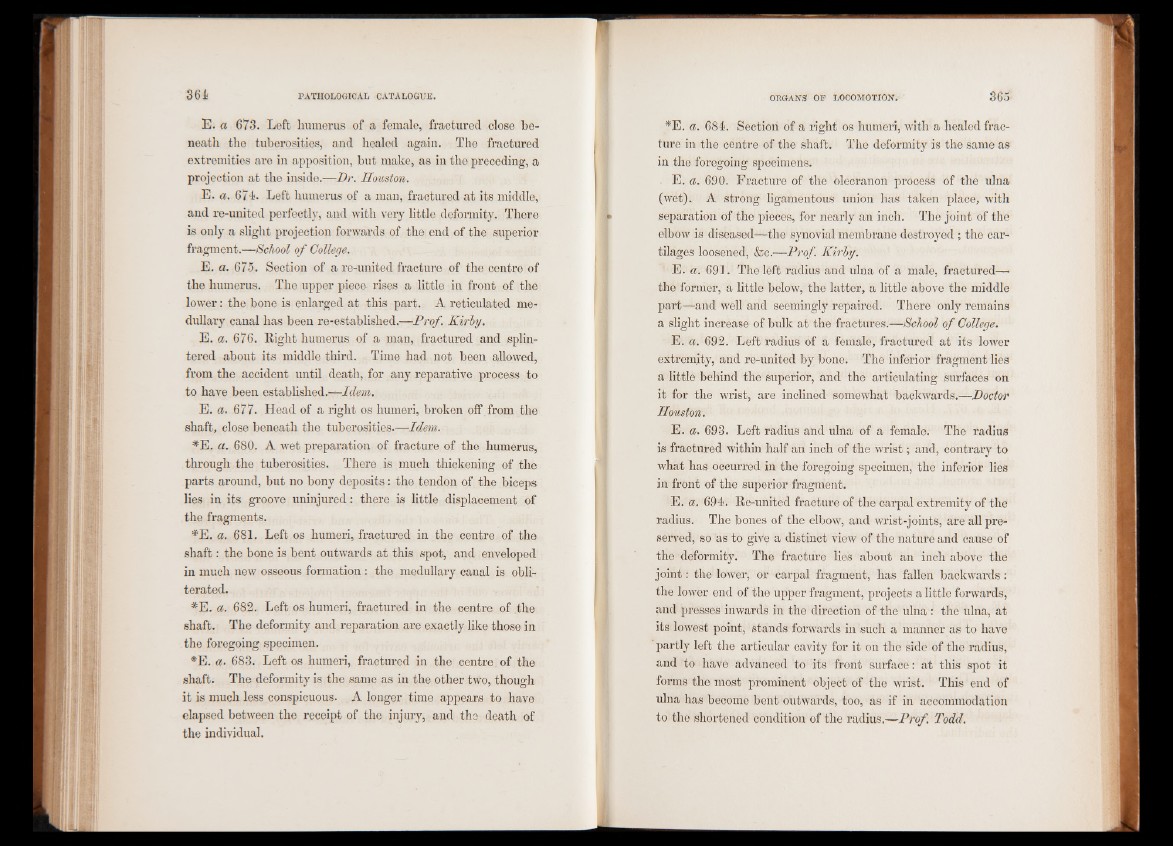
E. a 673. Left humerus of a female, fractured close beneath
the tuberosities, and healed again. The fractured
extremities are in apposition, but make, as in the preceding, a
projection at the inside.—D r. Houston.
E. a. 674. Left humerus of a man, fractured at its middle,
and re-united perfectly, and with very little deformity. There
is only a slight projection forwards of the end of the superior
fragment.—School o f College.
E. a. 675. Section of a re-united fracture of the centre of
the humerus. The upper piece rises a little in front of the
lower: the bone is enlarged at this part. A reticulated medullary
canal has been re-established.—Prof. K irby.
E. a. 676. Right humerus of a man, fractured and splintered
about its middle third. Time had not been allowed,
from the accident until death, for any reparative process to
to have been established.—
E. a. 677. Head of a right os humeri, broken off from the
shaft, close beneath the tuberosities.—Idem.
*E. a. 680. A wet preparation of fracture of the humerus,
through the tuberosities. There is much thickening of the
parts around, but no bony deposits: the tendon of the biceps
lies in its groove uninjured: there is little displacement of
the fragments.
#E. a. 681. Left os humeri, fractured in the centre of the
shaft: the bone is bent outwards at this spot, and enveloped
in much new osseous formation : the medullary canal is obliterated.
#E. a. 682. Left os humeri, fractured in the centre of the
shaft. The deformity and reparation are exactly like those in
the foregoing specimen.
*E. a. 683. Left os humeri, fractured in the centre of the
shaft. The deformity is the same as in the other two, though
it is much less conspicuous. A longer time appears to have
elapsed between the receipt of the injury, and the death of
the individual.
*E. a. 684. Section of a right os humeri, with a healed fracture
in the centre of the shaft. The deformity is the same as
in the foregoing specimens.
E. a. 690. Fracture of the olecranon process of the ulna
(wet), A strong ligamentous union has taken place, with
separation of the pieces, for nearly an inch. The joint of the
elbow is diseased—the synovial membrane destroyed ; the cartilages
loosened, &e.—Prof. K irby.
E. a. 691. The left radius and ulna of a male, fractured—<
the former, a little below, the latter, a little above the middle
part—and well and seemingly repaired. There only remains
a slight increase of bulk at the fractures.—School of College.
E. a. 692. Left radius of a female, fractured at its lower
extremity, and re-united by bone. The inferior fragment lies
a little behind the superior, and the articulating surfaces on
it for the wrist, are inclined somewhat backwards.—Doctor
Houston.
E. a. 693. Left radius and ulna of a female. The radius
is fractured within half an inch of the wrist; and, contrary to
what has occurred in the foregoing specimen, the inferior lies
in front of the superior fragment.
E. a. 694. Re-united fracture of the carpal extremity of the
radius. The bones of the elbow, and wrist-joints, are all preserved,
so as to give a distinct view of the nature and cause of
the deformity. The fracture lies about an inch above the
joint: the lower, or carpal fragment, has fallen backwards:
the lower end of the upper fragment, projects a little forwards,
and presses inwards in the direction of the ulna : the ulna, at
its lowest point, stands forwards in such a manner as to have
partly left the articular cavity for it on the side of the radius,
and to have advanced to its front surface: at this spot it
forms the most prominent object of the wrist. This end of
ulna has become bent outwards, too, as if in accommodation
to the shortened condition of the radius.—P rof. Todd.